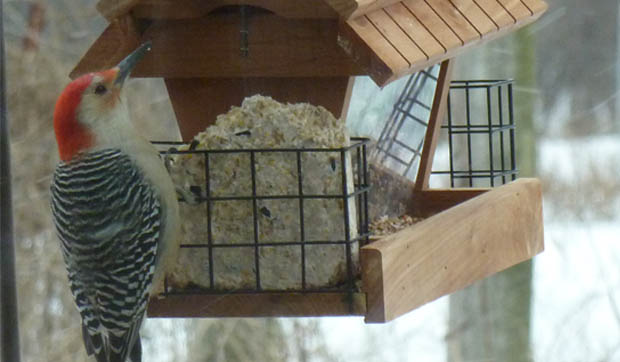A male red-bellied woodpecker takes advantage of the free buffet at the Hickory Knolls birdfeeders. Offering a variety of seeds, in a variety of feeder styles–tube, platform, hopper, suet–will in turn attract a variety of species.
Choosing Birdseed
November 24, 2017
November typically is the time folks send out invitations for holiday gatherings, be they in the house or out by the birdfeeders.
That’s right, hanging up a birdfeeder is akin to issuing an invitation to a party. The only difference is, you have no control over the guest list.
Well, make that minimal control.
Although you can’t dictate who can come to your free buffet, there are certain things you can do to, if not control, at least influence who or what comes to feed on your seeds. And you don’t have to hire a feathered bouncer to do it.
The first step you can take actually begins not at the feeder, but at the feed store. You know how at the butcher shop you can choose between the bargain cuts, all fatty and gristly, and the fancy cuts, with their picture-perfect marbling and soft-as-butter texture? Even if you knew nothing about meat, you could probably tell that one hunk is better than other just by looking at the price.
It’s the same with birdseed. Some seed mixes are loaded, not with fat and gristle, but with “filler” grains that most birds want nothing to do with. Milo, for example, is a bulky seed with little nutritional value. It’s cheap to produce though and it takes up lots of space, so you’ll find it in quantity in many inexpensive birdseed mixes.
Although some birds, like doves, pheasants and wild turkeys, seem to be attracted by milo, most songbird species shun it and kick it to the ground. There it sits, attracting the attention of starlings and other party-poopers. If you don’t like these guys at your feeders, spend a little bit more on your seed; get the tender filet instead of the chewy shoe leather.
One seed you can’t go wrong with is black oil sunflower. A 50-lb. bag might cost you $40 or more (less if you find a sale) but you’ll be rewarded with visits from all sorts of delightful guests-chickadees, nuthatches, finches and woodpeckers, to name a few.
It’s true, black oil sunflower seeds are popular not only with birds, but also mammals-particularly squirrels. If you would rather not have squirrels come to your party, try swapping sunflower seeds for safflower. Squirrels don’t care for it, but many songbirds do. If you do decide to try this method, be sure and introduce the safflower gradually, mixing it in with the sunflower seeds and slowly increasing the ratio. Just as you would be suspicious if your favorite restaurant switched menus overnight, so too are birds.
Another common method of deterring squirrels has been to add ground cayenne pepper to the seeds. Squirrels can taste and feel capsaicin, the chemical that gives the pepper its heat, but birds can not. However, studies have shown that even though birds lack the nerve endings needed to feel the pepper in their mouths, they can still have a bad reaction to the dust if it gets into their nose or eyes. Hence, this method is best avoided. Good party hosts don’t spatter their guests with pepper spray, and neither should you.
Getting back to the banquet, another must-have at the birdseed buffet-especially in winter-is suet cakes. Packed with high-calorie fat, these blocks provide the energy birds need to survive winter’s extreme temperatures.
As with birdseed, it pays to read the label when purchasing bird suet. Look for the words “beef kidney suet” on the label; this sort offers more quality calories than tallow or shortening. Also, if you’re tempted by suet cakes with tasty-looking nuts, fruits and seeds, make sure those added ingredients don’t outweigh the suet itself. While enticing, these garnishes aren’t as nutrient-dense as suet and might cause your suet cake to fall apart or erode away more quickly during a winter storm.
One final tip addresses the timing of your party. The species of birds that come to feeders are diurnal, or active during daylight hours. Yet some of your feeding area’s biggest party crashers – namely raccoons and opossums – are nocturnal, or active at night. Even deer, which can do a number on feeders and your birdseed budget, usually feed at dawn and dusk and not peak daytime hours.
So, if you’re finding your feeders are a mess come morning, do the easy thing and bring them in each evening. If you don’t want to bring them all the way inside, and risk drawing mice or other critters into your porch or garage, get a metal box or some galvanized garbage cans (which also are great for storing birdseed bought in quantity). Weigh the top down with a brick or two and, ta-da, the problem of midnight feeder marauders is solved.
Just be sure to hang the feeders back up again the next day, so the party can begin once again.
Pam Erickson Otto is the manager of nature programs and interpretive services at the Hickory Knolls Discovery Center, a facility of the St. Charles Park District. She can be reached at 630-513-4346 or potto@stcparks.org.

